An official website of the United States government
 United States Department of Labor
United States Department of Labor
Drive ambulance or assist ambulance driver in transporting sick, injured, or convalescent persons. Assist in lifting patients.
Employment estimate and mean wage estimates for Ambulance Drivers and Attendants, Except Emergency Medical Technicians:
| Employment (1) | Employment RSE (3) |
Mean hourly wage |
Mean annual wage (2) |
Wage RSE (3) |
|---|---|---|---|---|
| 11,520 | 3.2 % | $ 16.55 | $ 34,420 | 0.9 % |
Percentile wage estimates for Ambulance Drivers and Attendants, Except Emergency Medical Technicians:
| Percentile | 10% | 25% | 50% (Median) |
75% | 90% |
|---|---|---|---|---|---|
| Hourly Wage | $ 11.26 | $ 13.39 | $ 15.66 | $ 17.74 | $ 22.08 |
| Annual Wage (2) | $ 23,410 | $ 27,850 | $ 32,580 | $ 36,900 | $ 45,930 |
Industries with the highest published employment and wages for Ambulance Drivers and Attendants, Except Emergency Medical Technicians are provided. For a list of all industries with employment in Ambulance Drivers and Attendants, Except Emergency Medical Technicians, see the Create Customized Tables function.
Industries with the highest levels of employment in Ambulance Drivers and Attendants, Except Emergency Medical Technicians:
| Industry | Employment (1) | Percent of industry employment | Hourly mean wage | Annual mean wage (2) |
|---|---|---|---|---|
| Other Ambulatory Health Care Services | 7,110 | 2.06 | $ 15.85 | $ 32,980 |
| Local Government, excluding Schools and Hospitals (OEWS Designation) | 1,980 | 0.04 | $ 17.09 | $ 35,540 |
| General Medical and Surgical Hospitals | 1,090 | 0.02 | $ 18.82 | $ 39,140 |
| Other Transit and Ground Passenger Transportation | 530 | 0.54 | $ 17.60 | $ 36,610 |
| Outpatient Care Centers | 180 | 0.02 | $ 13.30 | $ 27,670 |
Industries with the highest concentration of employment in Ambulance Drivers and Attendants, Except Emergency Medical Technicians:
| Industry | Employment (1) | Percent of industry employment | Hourly mean wage | Annual mean wage (2) |
|---|---|---|---|---|
| Other Ambulatory Health Care Services | 7,110 | 2.06 | $ 15.85 | $ 32,980 |
| Other Transit and Ground Passenger Transportation | 530 | 0.54 | $ 17.60 | $ 36,610 |
| Other Support Services | 110 | 0.04 | $ 18.26 | $ 37,990 |
| Local Government, excluding Schools and Hospitals (OEWS Designation) | 1,980 | 0.04 | $ 17.09 | $ 35,540 |
| Outpatient Care Centers | 180 | 0.02 | $ 13.30 | $ 27,670 |
Top paying industries for Ambulance Drivers and Attendants, Except Emergency Medical Technicians:
| Industry | Employment (1) | Percent of industry employment | Hourly mean wage | Annual mean wage (2) |
|---|---|---|---|---|
| General Medical and Surgical Hospitals | 1,090 | 0.02 | $ 18.82 | $ 39,140 |
| Offices of Physicians | (8) | (8) | $ 18.48 | $ 38,450 |
| Colleges, Universities, and Professional Schools | 30 | (7) | $ 18.48 | $ 38,440 |
| Continuing Care Retirement Communities and Assisted Living Facilities for the Elderly | 40 | (7) | $ 18.30 | $ 38,070 |
| Other Support Services | 110 | 0.04 | $ 18.26 | $ 37,990 |
States and areas with the highest published employment, location quotients, and wages for Ambulance Drivers and Attendants, Except Emergency Medical Technicians are provided. For a list of all areas with employment in Ambulance Drivers and Attendants, Except Emergency Medical Technicians, see the Create Customized Tables function.
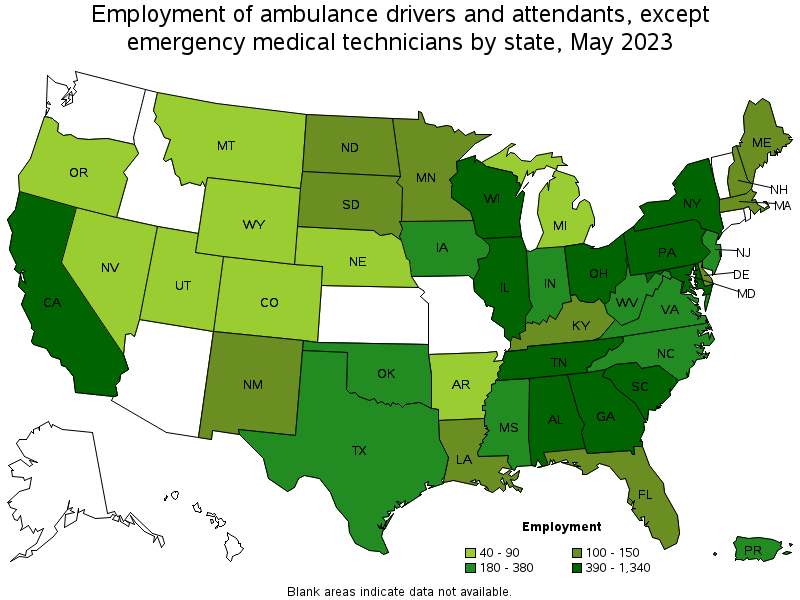
States with the highest employment level in Ambulance Drivers and Attendants, Except Emergency Medical Technicians:
| State | Employment (1) | Employment per thousand jobs | Location quotient (9) | Hourly mean wage | Annual mean wage (2) |
|---|---|---|---|---|---|
| California | 1,340 | 0.07 | 0.98 | $ 17.68 | $ 36,770 |
| South Carolina | 830 | 0.37 | 4.92 | $ 14.12 | $ 29,370 |
| New York | 630 | 0.07 | 0.88 | $ 19.14 | $ 39,800 |
| Georgia | 620 | 0.13 | 1.71 | $ 15.64 | $ 32,530 |
| Illinois | 550 | 0.09 | 1.21 | $ 16.35 | $ 34,000 |
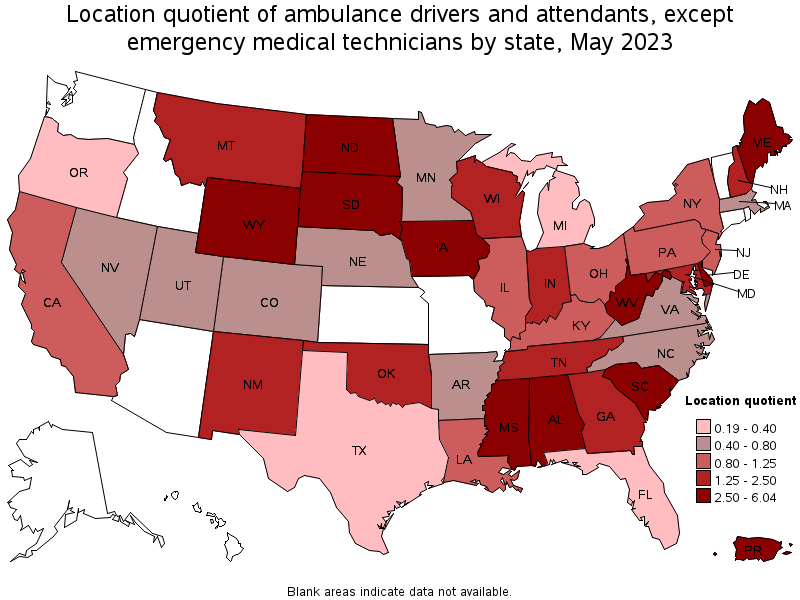
States with the highest concentration of jobs and location quotients in Ambulance Drivers and Attendants, Except Emergency Medical Technicians:
| State | Employment (1) | Employment per thousand jobs | Location quotient (9) | Hourly mean wage | Annual mean wage (2) |
|---|---|---|---|---|---|
| West Virginia | 320 | 0.46 | 6.04 | $ 12.09 | $ 25,140 |
| South Carolina | 830 | 0.37 | 4.92 | $ 14.12 | $ 29,370 |
| Mississippi | 380 | 0.33 | 4.34 | $ 12.45 | $ 25,890 |
| North Dakota | 130 | 0.32 | 4.25 | $ 16.23 | $ 33,760 |
| Wyoming | 80 | 0.29 | 3.80 | $ 19.00 | $ 39,530 |
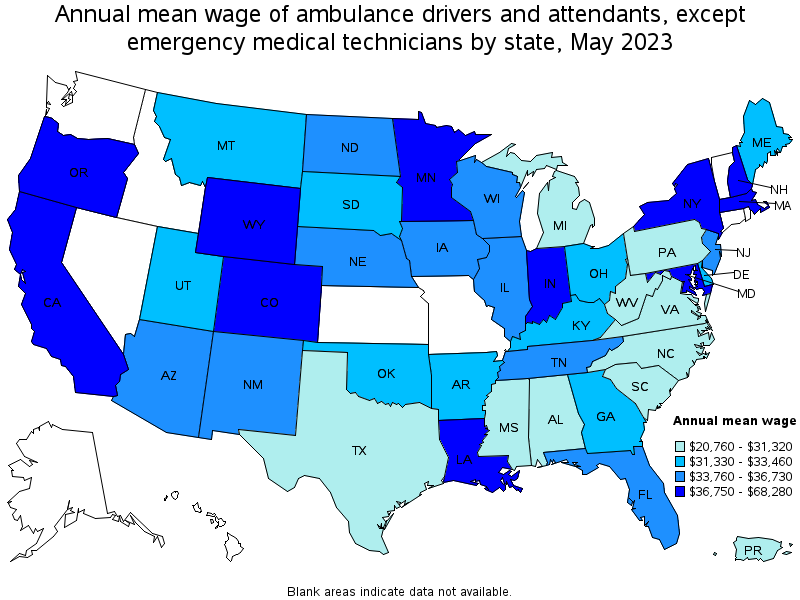
Top paying states for Ambulance Drivers and Attendants, Except Emergency Medical Technicians:
| State | Employment (1) | Employment per thousand jobs | Location quotient (9) | Hourly mean wage | Annual mean wage (2) |
|---|---|---|---|---|---|
| Louisiana | 130 | 0.07 | 0.92 | $ 32.83 | $ 68,280 |
| Minnesota | 110 | 0.04 | 0.50 | $ 20.09 | $ 41,790 |
| Maryland | 510 | 0.19 | 2.49 | $ 20.06 | $ 41,720 |
| Oregon | 40 | 0.02 | 0.24 | $ 19.74 | $ 41,070 |
| Massachusetts | 150 | 0.04 | 0.55 | $ 19.54 | $ 40,650 |
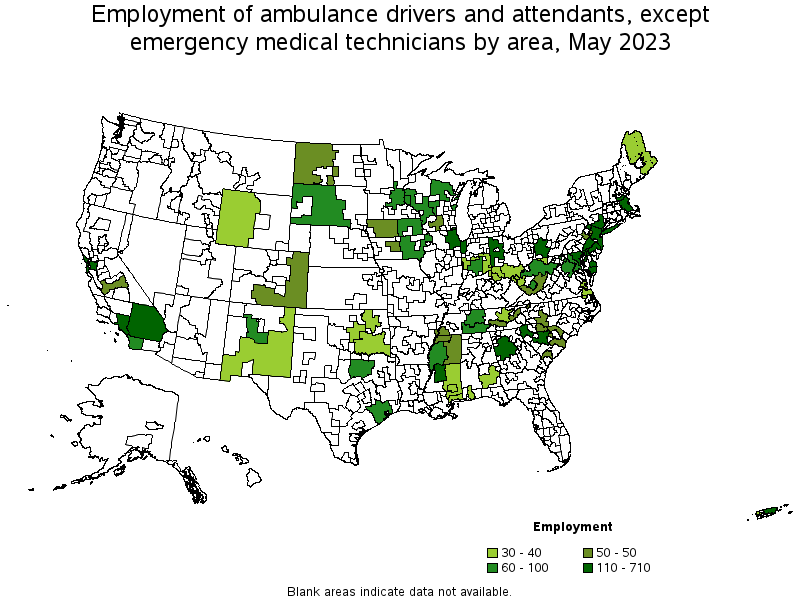
Metropolitan areas with the highest employment level in Ambulance Drivers and Attendants, Except Emergency Medical Technicians:
| Metropolitan area | Employment (1) | Employment per thousand jobs | Location quotient (9) | Hourly mean wage | Annual mean wage (2) |
|---|---|---|---|---|---|
| New York-Newark-Jersey City, NY-NJ-PA | 710 | 0.07 | 0.99 | $ 19.60 | $ 40,770 |
| Chicago-Naperville-Elgin, IL-IN-WI | 530 | 0.12 | 1.54 | $ 16.36 | $ 34,020 |
| Los Angeles-Long Beach-Anaheim, CA | 520 | 0.08 | 1.12 | $ 17.91 | $ 37,260 |
| Atlanta-Sandy Springs-Roswell, GA | 340 | 0.12 | 1.58 | $ 16.20 | $ 33,690 |
| Baltimore-Columbia-Towson, MD | 330 | 0.25 | 3.30 | $ 19.30 | $ 40,140 |
| Columbia, SC | 200 | 0.53 | 6.95 | $ 13.74 | $ 28,570 |
| Philadelphia-Camden-Wilmington, PA-NJ-DE-MD | 200 | 0.07 | 0.93 | $ 16.10 | $ 33,490 |
| San Francisco-Oakland-Hayward, CA | 180 | 0.07 | 0.96 | $ 18.45 | $ 38,370 |
| Riverside-San Bernardino-Ontario, CA | 160 | 0.10 | 1.29 | $ 16.95 | $ 35,250 |
| Greenville-Anderson-Mauldin, SC | 160 | 0.38 | 5.04 | $ 14.28 | $ 29,700 |
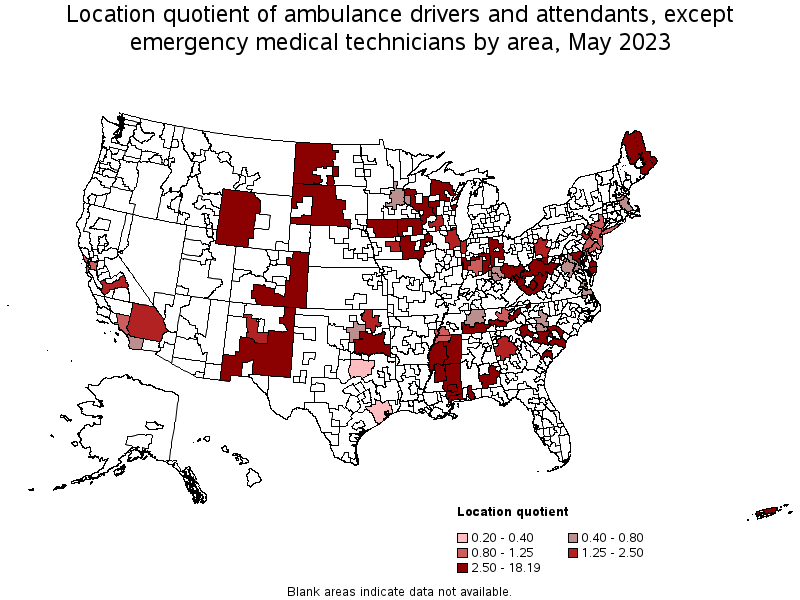
Metropolitan areas with the highest concentration of jobs and location quotients in Ambulance Drivers and Attendants, Except Emergency Medical Technicians:
| Metropolitan area | Employment (1) | Employment per thousand jobs | Location quotient (9) | Hourly mean wage | Annual mean wage (2) |
|---|---|---|---|---|---|
| Beckley, WV | 60 | 1.38 | 18.19 | $ 11.47 | $ 23,850 |
| Salisbury, MD-DE | 140 | 0.84 | 11.02 | $ 18.86 | $ 39,220 |
| Hattiesburg, MS | 40 | 0.63 | 8.33 | $ 12.21 | $ 25,400 |
| Columbia, SC | 200 | 0.53 | 6.95 | $ 13.74 | $ 28,570 |
| Morgantown, WV | 30 | 0.47 | 6.16 | $ 12.34 | $ 25,670 |
| Jackson, MS | 110 | 0.43 | 5.71 | $ 11.76 | $ 24,460 |
| Greenville-Anderson-Mauldin, SC | 160 | 0.38 | 5.04 | $ 14.28 | $ 29,700 |
| Daphne-Fairhope-Foley, AL | 30 | 0.38 | 4.97 | $ 13.46 | $ 28,000 |
| Huntington-Ashland, WV-KY-OH | 40 | 0.31 | 4.11 | $ 12.75 | $ 26,520 |
| Baltimore-Columbia-Towson, MD | 330 | 0.25 | 3.30 | $ 19.30 | $ 40,140 |
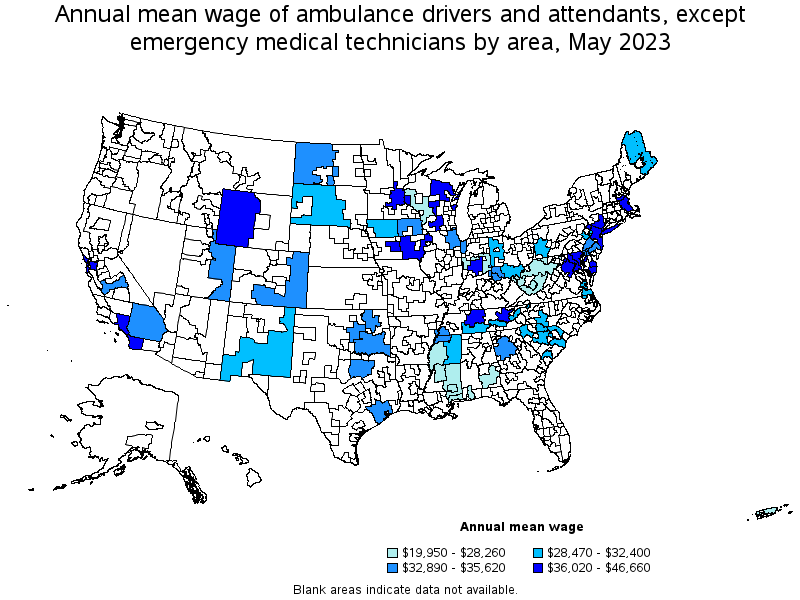
Top paying metropolitan areas for Ambulance Drivers and Attendants, Except Emergency Medical Technicians:
| Metropolitan area | Employment (1) | Employment per thousand jobs | Location quotient (9) | Hourly mean wage | Annual mean wage (2) |
|---|---|---|---|---|---|
| Nashville-Davidson--Murfreesboro--Franklin, TN | 60 | 0.06 | 0.78 | $ 22.43 | $ 46,660 |
| Indianapolis-Carmel-Anderson, IN | 90 | 0.08 | 1.05 | $ 21.12 | $ 43,930 |
| Washington-Arlington-Alexandria, DC-VA-MD-WV | 100 | 0.03 | 0.45 | $ 20.96 | $ 43,590 |
| Boston-Cambridge-Nashua, MA-NH | 130 | 0.05 | 0.60 | $ 19.66 | $ 40,890 |
| New York-Newark-Jersey City, NY-NJ-PA | 710 | 0.07 | 0.99 | $ 19.60 | $ 40,770 |
| Des Moines-West Des Moines, IA | 50 | 0.13 | 1.68 | $ 19.50 | $ 40,570 |
| Baltimore-Columbia-Towson, MD | 330 | 0.25 | 3.30 | $ 19.30 | $ 40,140 |
| Knoxville, TN | 30 | 0.08 | 0.99 | $ 19.24 | $ 40,010 |
| Salisbury, MD-DE | 140 | 0.84 | 11.02 | $ 18.86 | $ 39,220 |
| Minneapolis-St. Paul-Bloomington, MN-WI | 100 | 0.05 | 0.68 | $ 18.66 | $ 38,820 |
Nonmetropolitan areas with the highest employment in Ambulance Drivers and Attendants, Except Emergency Medical Technicians:
| Nonmetropolitan area | Employment (1) | Employment per thousand jobs | Location quotient (9) | Hourly mean wage | Annual mean wage (2) |
|---|---|---|---|---|---|
| West Northwestern Ohio nonmetropolitan area | 120 | 0.47 | 6.25 | $ 13.69 | $ 28,470 |
| South Central Tennessee nonmetropolitan area | 100 | 0.87 | 11.51 | $ 15.17 | $ 31,550 |
| Western Wisconsin nonmetropolitan area | 80 | 0.62 | 8.15 | $ 12.56 | $ 26,120 |
| Northern West Virginia nonmetropolitan area | 70 | 0.55 | 7.22 | $ 11.57 | $ 24,060 |
| Northeastern Wisconsin nonmetropolitan area | 70 | 0.36 | 4.72 | $ 18.73 | $ 38,950 |
Nonmetropolitan areas with the highest concentration of jobs and location quotients in Ambulance Drivers and Attendants, Except Emergency Medical Technicians:
| Nonmetropolitan area | Employment (1) | Employment per thousand jobs | Location quotient (9) | Hourly mean wage | Annual mean wage (2) |
|---|---|---|---|---|---|
| West South Dakota nonmetropolitan area | 60 | 1.03 | 13.60 | $ 14.34 | $ 29,830 |
| South Central Tennessee nonmetropolitan area | 100 | 0.87 | 11.51 | $ 15.17 | $ 31,550 |
| Southern West Virginia nonmetropolitan area | 50 | 0.76 | 9.98 | $ 11.92 | $ 24,800 |
| Eastern and Southern Colorado nonmetropolitan area | 50 | 0.72 | 9.48 | $ 17.03 | $ 35,420 |
| Northwest Mississippi nonmetropolitan area | 60 | 0.71 | 9.40 | $ 12.51 | $ 26,020 |
Top paying nonmetropolitan areas for Ambulance Drivers and Attendants, Except Emergency Medical Technicians:
| Nonmetropolitan area | Employment (1) | Employment per thousand jobs | Location quotient (9) | Hourly mean wage | Annual mean wage (2) |
|---|---|---|---|---|---|
| Western Wyoming nonmetropolitan area | 40 | 0.44 | 5.82 | $ 19.62 | $ 40,800 |
| Northeastern Wisconsin nonmetropolitan area | 70 | 0.36 | 4.72 | $ 18.73 | $ 38,950 |
| Southeast Iowa nonmetropolitan area | 60 | 0.29 | 3.84 | $ 18.58 | $ 38,640 |
| Southeast Oklahoma nonmetropolitan area | 40 | 0.25 | 3.29 | $ 17.07 | $ 35,500 |
| Eastern and Southern Colorado nonmetropolitan area | 50 | 0.72 | 9.48 | $ 17.03 | $ 35,420 |
These estimates are calculated with data collected from employers in all industry sectors, all metropolitan and nonmetropolitan areas, and all states and the District of Columbia. The top employment and wage figures are provided above. The complete list is available in the downloadable XLS files.
The percentile wage estimate is the value of a wage below which a certain percent of workers fall. The median wage is the 50th percentile wage estimate—50 percent of workers earn less than the median and 50 percent of workers earn more than the median. More about percentile wages.
(1) Estimates for detailed occupations do not sum to the totals because the totals include occupations not shown separately. Estimates do not include self-employed workers.
(2) Annual wages have been calculated by multiplying the hourly mean wage by a "year-round, full-time" hours figure of 2,080 hours; for those occupations where there is not an hourly wage published, the annual wage has been directly calculated from the reported survey data.
(3) The relative standard error (RSE) is a measure of the reliability of a survey statistic. The smaller the relative standard error, the more precise the estimate.
(7) The value is less than .005 percent of industry employment.
(8) Estimate not released.
(9) The location quotient is the ratio of the area concentration of occupational employment to the national average concentration. A location quotient greater than one indicates the occupation has a higher share of employment than average, and a location quotient less than one indicates the occupation is less prevalent in the area than average.
Other OEWS estimates and related information:
May 2023 National Occupational Employment and Wage Estimates
May 2023 State Occupational Employment and Wage Estimates
May 2023 Metropolitan and Nonmetropolitan Area Occupational Employment and Wage Estimates
May 2023 National Industry-Specific Occupational Employment and Wage Estimates
Last Modified Date: April 3, 2024